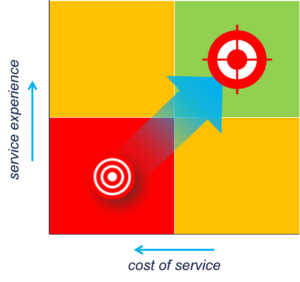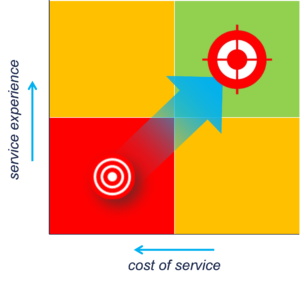This is Demand Driven SCM – Part 1

Demand Driven Supply Chain Management (DDSCM) is becoming increasingly popular – and deservedly so, in our opinion, because DDSCM offers huge potential – but the rate of adoption is still too slow for our liking. One thing holding it back could be the lack of a clear definition of what exactly DDSCM is. This is leading to many different interpretations, very few of which do justice to the real essence of DDSCM. In an attempt to resolve this, we have created this four-parter to share our views of – and our experiences with – DDSCM. Needless to say, we will address the issue of what DDSCM is and hence also what it is not. Besides that, we will explain why you should want to start working with DDSCM and how it could help you. Last but not least, we will present a useful tool to enable you to devise your own DDSCM improvement strategy and solutions.
Break the service paradox!
For many years now, we have seen countless companies struggling to improve their service experience while reducing their cost of service – or, in other words, to become both better and cheaper with less hassle. Despite the best of intentions, however, most of them have failed to make a real breakthrough – hence the fact that this is sometimes referred to as the seemingly insurmountable ‘service paradox’ (Frei, 2006).
Thankfully, we have seen a small but growing number of companies managing to break this paradox more recently, and their secret is surprisingly straightforward. They simply refuse to accept their dependence on chronically unreliable forecasts and plans any longer. Instead, by eliminating unnecessary variation and uncertainty and by bringing forward riskless decisions, they have been able to delay risky decisions in order to successfully escape from what we have termed the ‘Planning Mismatch’. We will go into this in more detail later, but let’s first look at a little background information.
Alignment is a prerequisite
Alignment is essential if you are to escape from the service paradox. After all, in order to become both better and cheaper, everyone everywhere must always do the right thing and make the right decisions – not in their own local interests, but for the good of the whole. That means taking an integral chain-based approach to supplying what the end customer wants, when the customer wants it and without waste. We call that ‘Demand Driven’ alignment.
Of course, the million-dollar question is how to achieve demand-driven alignment. Needless to say, carefully formulated targets and key performance indicators (KPIs) play an important role in that. Effective targets and KPIs stimulate the desired behaviour and right decisions, and discourage undesired behaviour and wrong decisions. In practice, however, this is not quite so easy. After all, it is not uncommon for targets and KPIs to be beyond your scope of influence, especially externally. Luckily, there is another factor that you can influence, namely the ‘moment of decision’.
In Part Two of this four-parter, we will explore the link between the right moment of decision and demand-driven alignment.
This brings us to the end of Part One of our four-parter on Demand Driven Supply Chain Management. If you would like to know more, feel free to contact Alex Tjalsma: a.tjalsma@involvation.com



